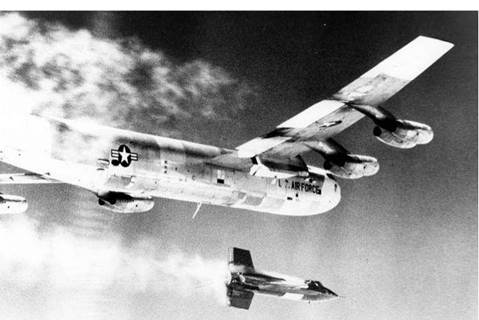LAUNCH SYSTEMS
In the history of manned space flight, there have been numerous designs for systems to carry people into space. Many have reached the point of almost making a manned space launch, but have been cancelled prior to the event. Between 1961 and 2006, there have been just two “rocket planes” (X-15 and Spaceship One) that have touched space, while only eight launch systems (seven rockets and the Shuttle) have actually achieved manned space launcher status.
Astro-flights
Throughout the space age, there has been a worldwide uncertainty as to precisely where the atmosphere ends and space begins. Some say 50 miles (80.45 km), others 62 miles (100 km), and there are those who claim it doesn’t happen until you are in orbit. However, the X-15 rocket plane reached altitudes of between 50.70 and 66.75 miles
|
An X-15 is launched from beneath a B-52 bomber |
(81.59 and 107.42km) on thirteen “astro-flights” by eight pilots between July 1962 and August 1968. In the early 1960s, the USAF decided that a military pilot making a flight over 50 miles (80.45 km) would be eligible for the rating of Air Force Astronaut Pilot and awarded Astronaut Wings to those who achieved it. The five US Air Force pilots were awarded Astronaut Wings at the time, but the three civilian pilots had to wait until 2006 to receive theirs. The award should also therefore be given to Mike Melvill and Brian Binnie, who flew the space tourist prototype vehicle Spaceship One in 2004.
The X-15 flights used the B-52 aircraft to “air-launch” the rocket research plane by dropping it from beneath the wing, usually at about 45,000 ft (13,716 m), where it began its descent to the ground either as a glide flight or by igniting its engines and completing its mission. Spaceship One was carried to 13,716 m and 14,356m by the White Knight launch aircraft for its two record-breaking missions.











